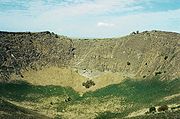
Mount Schank
Encyclopedia

Maar
A maar is a broad, low-relief volcanic crater that is caused by a phreatomagmatic eruption, an explosion caused by groundwater coming into contact with hot lava or magma. A maar characteristically fills with water to form a relatively shallow crater lake. The name comes from the local Moselle...
volcano
Volcano
2. Bedrock3. Conduit 4. Base5. Sill6. Dike7. Layers of ash emitted by the volcano8. Flank| 9. Layers of lava emitted by the volcano10. Throat11. Parasitic cone12. Lava flow13. Vent14. Crater15...
in the south-east of South Australia
South Australia
South Australia is a state of Australia in the southern central part of the country. It covers some of the most arid parts of the continent; with a total land area of , it is the fourth largest of Australia's six states and two territories.South Australia shares borders with all of the mainland...
, near Mount Gambier
Mount Gambier, South Australia
Mount Gambier is the largest regional city in South Australia located approximately 450 kilometres south of the capital Adelaide and just 17 kilometres from the Victorian border....
. It was named by James Grant
James Grant (navigator)
James Grant was a British Royal Navy officer and navigator in the early nineteenth century. He made several voyages to Australia and Tasmania, and was the first to map parts of the south coast of Australia.-Early life:...
in 1800 after Admiral John Schank
John Schank
Admiral John Schank was an officer of the British Royal Navy known for his skill in ship construction and mechanical design.-Biography:...
, designer of Grant's ship, the HMS Lady Nelson
Lady Nelson
The Royal Navy purchased Lady Nelson in 1799. She spent her career exploring the coast of Australia in the early years of the 19th century. She was the first known vessel to sail eastward through Bass Strait, the first to sail along the South coast of Victoria, as well as the first to enter Port...
.
Mount Schank was created by the East Australia hotspot
East Australia hotspot
The East Australia hotspot is a volcanic hotspot that forces magma up at weak spots in the Indo-Australian Plate to form volcanoes in Eastern Australia. There have been no eruptions in Australia during historic times. It does not produce a single chain of volcanoes like the Hawaiian Islands...
in the Holocene
Holocene
The Holocene is a geological epoch which began at the end of the Pleistocene and continues to the present. The Holocene is part of the Quaternary period. Its name comes from the Greek words and , meaning "entirely recent"...
, 5,000 years ago, at the same time as Mount Gambier
Mount Gambier (volcano)
Mount Gambier is a maar complex in South Australia associated with the Newer Volcanics Province. It contains four lake-filled maars called Blue Lake, Valley Lake, Leg of Mutton Lake, and Brownes Lake...
. It is a very basic ash cone perhaps a hundred metres high, and the base of the crater does not extend below the water table, so there is no crater lake as with those at Mount Gambier. There are two small subsidiary craters adjacent to the main cone and some lava flows resulting from the eruption. The northern crater is circular and 300 m in diameter, the older southern crater is 200 m in diameter and partially overlapped by the larger crater. Lava nearby shows quench features, typical of rapid cooling brought about by contact with seawater. This suggests that the area was covered by the sea when the eruption occurred; unsurprising, as today the volcano is around 15 km north of the shore. Mount Schank is part of the Newer Volcanics Province
Newer Volcanics Province
The Newer Volcanics Province is a complex of volcanic centres formed by the East Australia hotspot across south-eastern Australia. It has an area of 6,000 square miles with over 400 vents and contains the youngest volcanoes in Australia...
, which is the youngest volcanic center in Australia
Australia
Australia , officially the Commonwealth of Australia, is a country in the Southern Hemisphere comprising the mainland of the Australian continent, the island of Tasmania, and numerous smaller islands in the Indian and Pacific Oceans. It is the world's sixth-largest country by total area...
.
The local Aboriginal
Indigenous Australians
Indigenous Australians are the original inhabitants of the Australian continent and nearby islands. The Aboriginal Indigenous Australians migrated from the Indian continent around 75,000 to 100,000 years ago....
Bunganditj people witnessed Mount Schank's eruptions over time. Their creation story about the local volcanic landscape was recorded by a local woman, Cristina Smith, in 1880. It tells the tale of Craitbul, a giant, who was looking for a place to live with his wife and two sons. They camped at Mount Muirhead and Mount Schank, but were scared away from both these camps by a moaning bird spirit. They fled to Mount Gambier, leaving their camp ovens (the volcanoes) burning. After some time, water came and filled their ovens, putting them out and driving the spirit away. They continued to live in a cave on the side of Mount Gambier.

Port MacDonnell, South Australia
Port MacDonnell is a small port about southeast of Adelaide and south of Mount Gambier, in the Limestone Coast region of south-eastern South Australia. Port MacDonnell is the southernmost town in South Australia. At the 2006 census, the town had a population of 623...
road about 12 km south of Mount Gambier; there is a small carpark and picnic table, and steps have been placed to facilitate the short but very steep walk to the rim of the crater. It is a fairly simple walk to traverse the rim, though the exposed situation can be treacherous in gusty weather.

